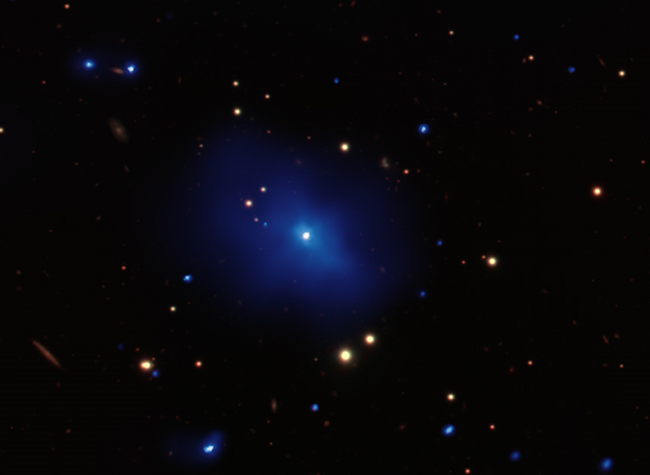Distant Galaxy Cluster Has a Cold Quasar Heart

A space telescope has spotted astrange, distant galaxycluster with a cosmic heart that is surprisingly cold.
NASA's Chandra X-ray Observatorysnapped an image of thecluster, which is about 8 billion light-years from Earth. The clustersurroundsa bright object known as a quasar. This particular quasar iscalled 3C 186,making it the farthest galaxy cluster with a quasar ever seen. [X-rayimageof the cold quasar]
Quasars form at the central regionsof some galaxies, where giantblack holes gobble up matter so furiously that the remainingstuff aroundthem generates tremendous energy transmissions that span the entireelectromagneticspectrum, including radio waves, light and X-rays. They are some of thebrightest objects in the universe.
But the heart of the galaxy clusterstudied by the Chandraobservatory is only cold in astronomical terms.
The gas at the cluster's center is amere 30 million degreesFahrenheit (16.7 million degrees Celsius), while stuff at the outskirtstopsout around 80 million degrees Fahrenheit (44.4 million Celsius). Whilethatseems scorching hot to the average human, for quasars it's positivelychilly,researchers said.
This drop in temperature occursbecause intense X-rayemission from the gas nearer the core cools it down, the researchersadded.
The galaxy cluster surrounding quasar3C 186 is the mostdistant one ever found containing a quasar.It's also the most distant cluster ever observed with a cooling core.Thefaraway object could therefore provide insight into how quasars formandclusters grow, researchers said.
Breaking space news, the latest updates on rocket launches, skywatching events and more!
Because it took 8 billion years forthe cluster's light toreach Chandra's instruments, researchers are seeing it as it appearedwhen theuniverse was still relatively young ? less than half its current age ofabout 13.7billion years.
Previous observations have revealedlarge numbers ofclusters with strong cooling cores closer to Earth, less than about 6billionlight-years. But they appear to be more rare the farther awayresearchers look.
One reason for this may be that moredistant galaxyclusters ? which are younger, since astronomers are seeingthem at anearlier point in the universe's history ? merge more often with otherclustersor galaxies, researchers said.
These mergers would destroy thecooling cores. When coupledwith the fact that it takes cooling cores a long time to form, thiswould makethem rare in the earlier stages of the universe.
This cluster was found fortuitouslyvia a relatively modestChandra survey. So it's possible that many other similar objects existat largedistances, researchers said.
The picture of the clustersurrounding quasar 3C 186 is acomposite. It includes a new image from Chandra showing X-ray emissionsfromgas surrounding the point-like quasar near the center. Optical datafrom theGemini telescope in Chile contribute views of nearby stars and galaxies.
The research is detailed in the Oct.10 issue of theAstrophysical Journal.
- Top 10Strangest Things in Space
- Video:The Black Hole That Made You Possible
- Video:Quasar Interaction

Space.com is the premier source of space exploration, innovation and astronomy news, chronicling (and celebrating) humanity's ongoing expansion across the final frontier. Originally founded in 1999, Space.com is, and always has been, the passion of writers and editors who are space fans and also trained journalists. Our current news team consists of Editor-in-Chief Tariq Malik; Editor Hanneke Weitering, Senior Space Writer Mike Wall; Senior Writer Meghan Bartels; Senior Writer Chelsea Gohd, Senior Writer Tereza Pultarova and Staff Writer Alexander Cox, focusing on e-commerce. Senior Producer Steve Spaleta oversees our space videos, with Diana Whitcroft as our Social Media Editor.
